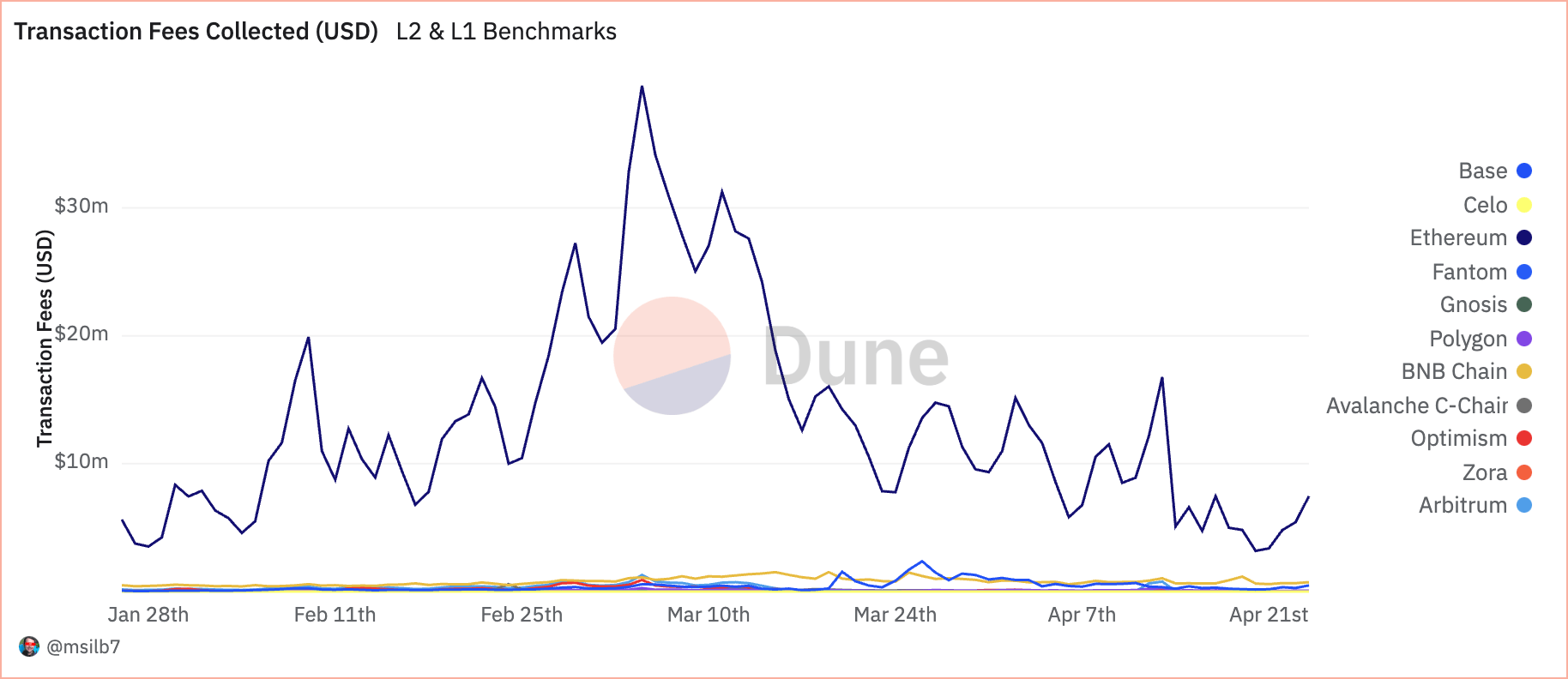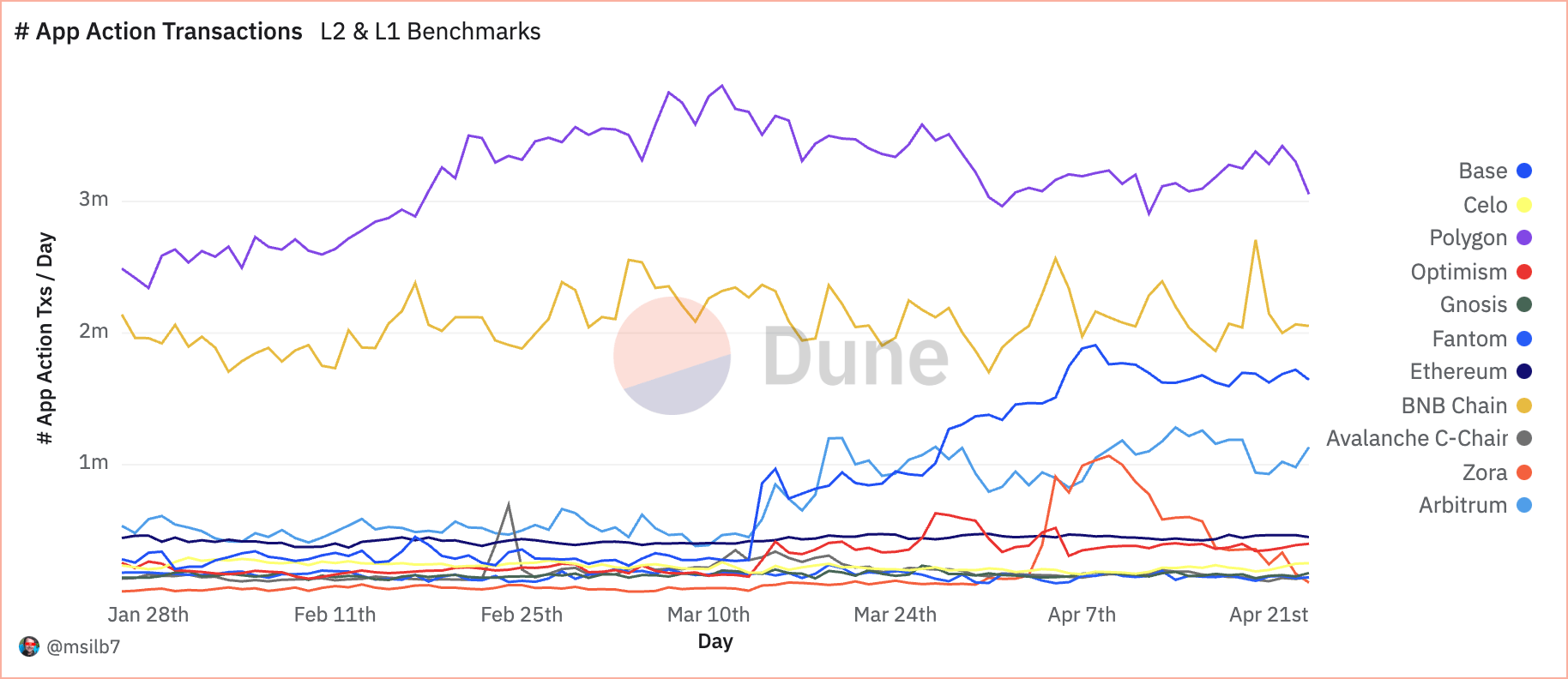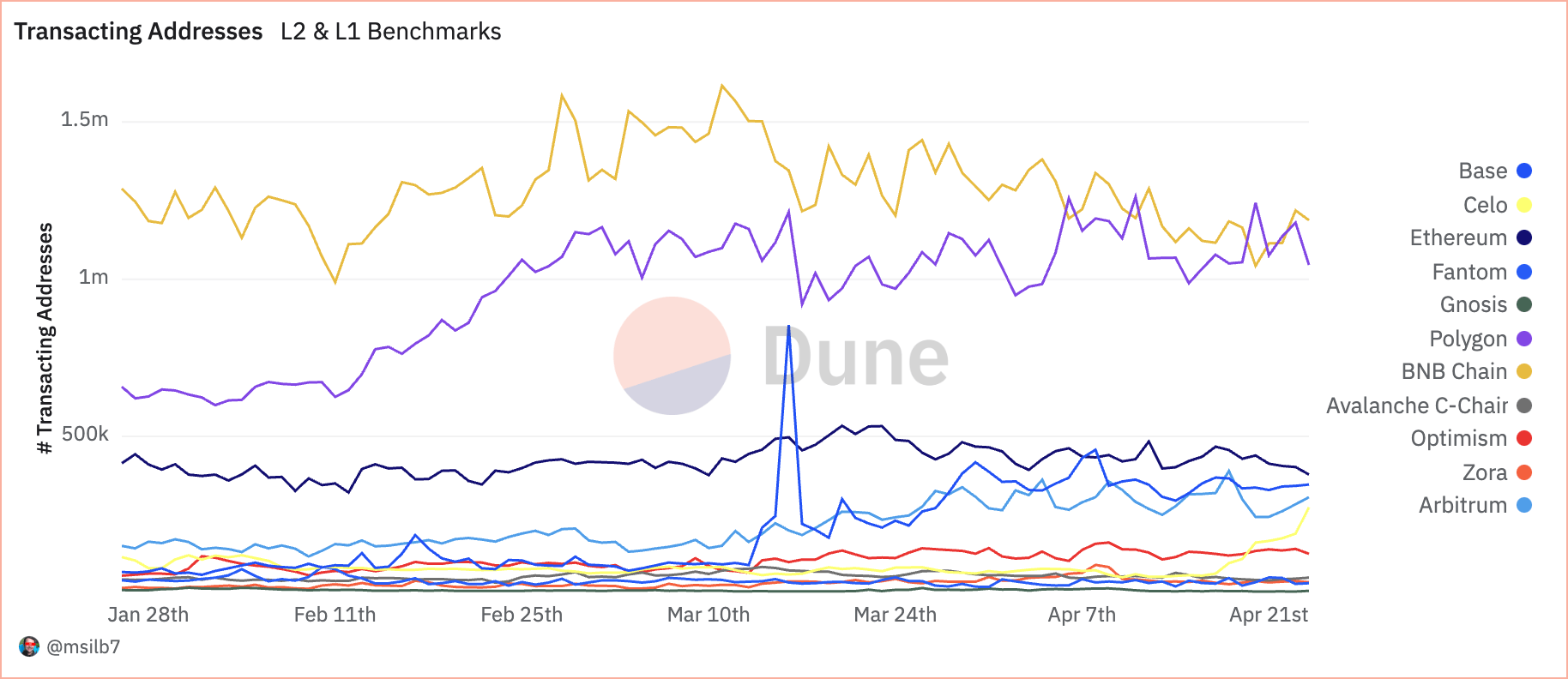Layer-1 blockchains are foundational networks supporting numerous functions immediately on their protocol, whereas Layer-2 blockchains function atop these foundational layers, enhancing scalability and effectivity. Evaluating the utilization and effectivity of EVM-compatible L1 and L2 blockchains and facet chains helps us higher perceive the market values and the place a lot of the DeFi exercise comes from.
Dune Analytics knowledge analyzed by CryptoSlate confirmed Polygon, a Layer-2 sidechain, was the main determine within the DeFi ecosystem, carefully adopted by BNB Chain, an EVM-compatible Layer-1 blockchain.
Probably the most necessary metrics when analyzing L1s and L2s is the each day gasoline utilization—the computational effort required to execute operations on the blockchain. Fuel charges are paid in native blockchain currencies, and excessive gasoline utilization usually signifies strong community exercise. Notably, when L2 options keep excessive gasoline utilization at low USD prices, it displays an environment friendly scaling resolution that makes transactions inexpensive with out sacrificing blockchain exercise.
Polygon makes use of a median of 579.97 billion items of native gasoline each day, with related prices amounting to only $65.48k. This interprets to a meager common of $0.76 in USD per second regardless of processing a excessive quantity of 48.37 transactions per second. Every transaction on Polygon prices about 138,782 gasoline items. BNB Mainnet, whereas additionally excessive in transaction quantity, exhibits a distinct value construction with 454.89 billion items of native gasoline used each day and $1.02 million in each day USD charges; the price per second soars to $11.81, far surpassing Polygon’s. The upper value per transaction, which averages 108,513 gasoline items, displays BNB’s heavier computational demand per transaction, suggesting a extra resource-intensive operation than Polygon.
| Chain | Avg Native Fuel Used / Day | Avg USD Fuel Charges / Day | Avg # Txs / Day | Avg Native Fuel per Tx | Avg Native Fuel Used / Second | Avg USD Fuel Charges / Second | Avg # Txs / Second |
|---|---|---|---|---|---|---|---|
| Polygon Mainnet | 579.97b | $65.48k | 4.18m | 138,782 | 6.71m | $0.76 | 48.37 |
| BNB Mainnet | 454.89b | $1.02m | 4.06m | 108,513 | 5.26m | $11.81 | 47.03 |
| Arbitrum One | 273.96b | $250.05k | 1.14m | 241,207 | 3.17m | $2.89 | 13.15 |
| Base Mainnet | 222.37b | $378.72k | 1.26m | 174,229 | 2.57m | $4.38 | 14.59 |
| OP Mainnet | 213.30b | $160.26k | 490.83k | 429,129 | 2.47m | $1.85 | 5.68 |
| Gnosis Mainnet | 109.77b | $1.05k | 182.58k | 601,244 | 1.27m | $0.01 | 2.11 |
| Ethereum Mainnet | 108.14b | $12.63m | 1.19m | 90,758 | 1.25m | $146.20 | 13.79 |
| Fantom Mainnet | 94.86b | $4.89k | 248.93k | 372,521 | 1.10m | $0.06 | 2.88 |
Arbitrum makes use of 273.96 billion items of gasoline each day, costing customers $250.05k, which breaks all the way down to $2.89 per second and 241,207 gasoline items per transaction, indicating the next value effectivity than BNB however much less so than Polygon. Base Mainnet data comparable developments with 222.37 billion items and each day charges of $378.72k, leading to a barely larger per-second value of $4.38 and 174,229 items per transaction.
Ethereum operates with the best value influence, utilizing 108.14 billion gasoline items each day, translating right into a hefty $12.63 million in charges. With prices skyrocketing to $146.20 per second, regardless of having a median of 90,758 gasoline items per transaction, it illustrates Ethereum’s strong safety and computational breadth and highlights its scalability challenges that L2 networks goal to deal with.
transaction metrics, knowledge from April 23 exhibits that Polygon led with 4.02 million transactions, adopted by BNB Chain with 3.9 million. These figures present sturdy consumer engagement and community utility, representing a respective 25.8% and 25.1% share of whole transactions (excluding identified system transactions).
Nonetheless, when inspecting transaction charges, a distinct narrative emerges. Regardless of a decrease transaction rely, Ethereum amassed $7.46 million in charges, representing a staggering 83.9% of whole charges collected. This discrepancy means that whereas Ethereum processes fewer transactions, its larger transaction prices mirror its major layer standing and the intensive computational sources required for operations.




In the case of DeFi apps, Polygon once more leads the transaction numbers, with 3.3 million app transactions, exhibiting it’s a go-to platform for DeFi actions.




BNB Chain noticed 1.22 million transacting addresses, with Polygon barely behind at 1.18 million. These figures, contrasted with Ethereum’s 402.77k, counsel that different EVM-compatible networks have gotten most well-liked platforms for normal DeFi customers on account of their decrease value buildings.




Analyzing the efficiency of those blockchains side-by-side exhibits a battle between foundational safety and enhanced scalability. Whereas L1 blockchains like Ethereum proceed to safe high-value transactions with substantial charges, scaling options like Polygon seize the majority of each day transactions and utility interactions, signifying a shift in the direction of extra environment friendly and user-friendly blockchain infrastructures in DeFi.
It’s necessary to notice that regardless of being labeled as a Layer-2 blockchain by many, Polygon operates as an L2 sidechain for Ethereum, because it depends by itself set of validators and doesn’t rely on Ethereum for safety. This permits Polygon to assist extra experimental exercise than “true” L2 blockchains with out impacting Ethereum. One other truth value mentioning is that BNB Chain is an EVM-compatible Layer-1 blockchain however has positioned itself in the marketplace not as a competitor to Ethereum, one other L1, however to different L2s.
